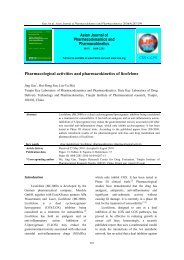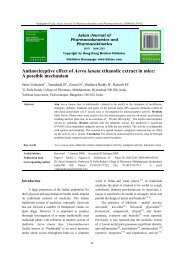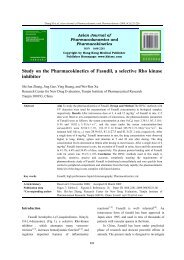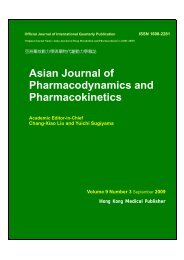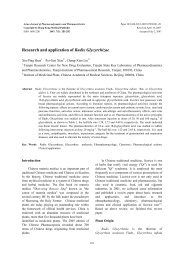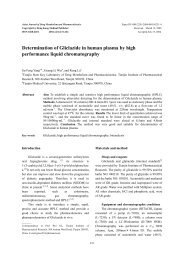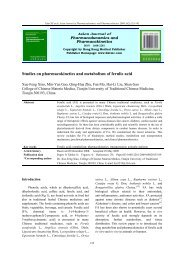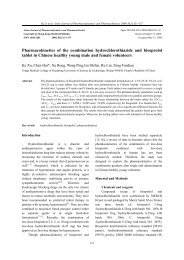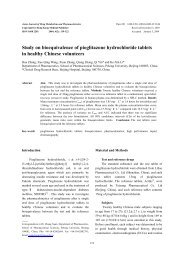Asian Journal of Pharmacodynamics and Pharmacokinetics
Asian Journal of Pharmacodynamics and Pharmacokinetics
Asian Journal of Pharmacodynamics and Pharmacokinetics
Create successful ePaper yourself
Turn your PDF publications into a flip-book with our unique Google optimized e-Paper software.
Cheng TF et al. <strong>Asian</strong> <strong>Journal</strong> <strong>of</strong> <strong>Pharmacodynamics</strong> <strong>and</strong> <strong>Pharmacokinetics</strong> 2009; 9(1):27-49<br />
China expect that the development <strong>of</strong> nanoscience<br />
<strong>and</strong> nanotechnology will greatly affect many areas<br />
<strong>of</strong> scientific research <strong>and</strong> industrial development,<br />
<strong>and</strong> many aspects <strong>of</strong> everyday life. [4]<br />
Research, development <strong>and</strong> application <strong>of</strong><br />
nanotechnology research in China can be summed<br />
up in three characteristics: the first, the government<br />
in support <strong>of</strong> sustainable development; the second,<br />
significant academic achievements, <strong>and</strong> the third, a<br />
clear consensus on nano-innovation.<br />
The government in support <strong>of</strong> sustainable<br />
development<br />
When the concept <strong>of</strong> nanoscience <strong>and</strong><br />
nanotechnology was first introduced in the 1980s, it<br />
was received favorably in China. The initial interest<br />
was in part stimulated by the development <strong>of</strong> new<br />
tools <strong>and</strong> techniques for observing materials on the<br />
nanoscale, especially scanning probe microscopes<br />
(SPMs). Soon after the concept began trickling<br />
through the scientific ranks, the Chinese Academy<br />
<strong>of</strong> Sciences (CAS), the National Natural Science<br />
Foundation <strong>of</strong> China (NSFC), <strong>and</strong> the State Science<br />
<strong>and</strong> Technology Commission (SSTC)/ the Ministry<br />
<strong>of</strong> Science <strong>and</strong> Technology (MOST) began funding<br />
nanoscience-related work <strong>and</strong> activities. China also<br />
has helped those who work in nanoscience <strong>and</strong><br />
nanotechnology to develop their sense <strong>of</strong> being part<br />
<strong>of</strong> a new research <strong>and</strong> development community.<br />
Since 1990, for example, dozens <strong>of</strong> international<br />
<strong>and</strong> domestic conferences in the field have been<br />
held in China. These conferences addressed a wide<br />
range <strong>of</strong> topics in nanoscience <strong>and</strong> nanotechnology<br />
<strong>and</strong> attracted wide attention <strong>and</strong> public interest. In<br />
the 1990s, support for the development <strong>of</strong><br />
nanoscience <strong>and</strong> nanotechnology increased<br />
substantially, largely through several major<br />
initiatives. In 1990, for example, SSTC launched<br />
the nearly decade-long "Climbing Up" project on<br />
nanomaterial science. In 1999, MOST started a<br />
national basic research project (“973” Plan) entitled<br />
"Nanomaterial <strong>and</strong> Nanostructure" <strong>and</strong> has been<br />
funding basic research on nanomaterials, such as<br />
nanotubes, ever since. China National High<br />
Technology Plan(“863” Plan), which encompasses<br />
many categories <strong>of</strong> technology, has included a<br />
series <strong>of</strong> projects for nanomaterial applications.<br />
From 1990 to 2005 alone, over 1200 projects were<br />
implemented. In addition, during this period, NSFC<br />
approved nearly 1000 grants for small-scale projects<br />
in related areas. With so much going on in<br />
nano-related R&D in so many different places in<br />
China, we created in 2000 the National Steering<br />
Committee for Nanoscience <strong>and</strong> Nanotechnology to<br />
oversee national policy <strong>and</strong> planning in these<br />
arenas. [4]<br />
Moving forward in nanoscience <strong>and</strong><br />
nanotechnology requires a particularly wide<br />
spectrum <strong>of</strong> skills <strong>and</strong> knowledge. The dem<strong>and</strong> for<br />
multidisciplinary research platforms with<br />
components assembled from academia <strong>and</strong> industry<br />
<strong>and</strong> that also have educational functions has become<br />
especially strong in recent years. According to<br />
incomplete statistics, more than 50 universities, 50<br />
institutes <strong>and</strong> over 300 industry enterprises in China<br />
have engaged in nanoscience <strong>and</strong> nanotechnology<br />
research <strong>and</strong> development, with the involvement <strong>of</strong><br />
more than 3000 researchers across China. To move<br />
forward <strong>and</strong> become more competitive in<br />
nanoscience <strong>and</strong> nanotechnology, China needs to<br />
continue to exp<strong>and</strong> its now-limited research<br />
infrastructure. In some areas, such as nanoscale<br />
devices with novel electronic <strong>and</strong> optoelectronic<br />
features, efforts to consolidate resources to tackle<br />
key technological issues are under way. Efforts<br />
have also been made to pursue industrial-scale<br />
production <strong>of</strong> nanomaterials, such as CNTs,<br />
polymeric nanocomposites, <strong>and</strong> nanoparticle<br />
materials, with the intention <strong>of</strong> opening up<br />
opportunities for new businesses to sprout <strong>and</strong> grow.<br />
The nanoscience <strong>and</strong> nanotechnology community in<br />
China has made remarkable advances across the<br />
research <strong>and</strong> development spectrum, from<br />
fundamental scientific research to studies into the<br />
potential societal implications <strong>of</strong> new<br />
nanotechnologies. China still has a long way to go<br />
to improve the overall competitiveness <strong>of</strong> its<br />
nanoscience <strong>and</strong> nanotechnology enterprise. [4]<br />
During the Ninth Five-year Plan period<br />
(1996-2000), the national “863” Plan supported by<br />
China government starts the projects <strong>of</strong> improving<br />
nanobiotechnology; during the Tenth Five-year<br />
period (2001-2005) national 863 <strong>and</strong> 973<br />
Plans <strong>and</strong> National Natural science made<br />
29



